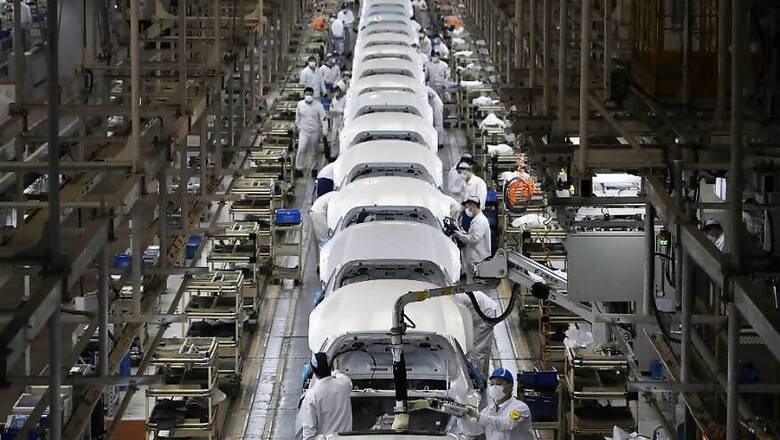
views
New Delhi: The first two months of the year brought cheer to cement makers, with demand for this essential construction raw material rising seven per cent in January and February over the same period of the previous year. But then, the covid-19 pandemic forced the government to declare a nationwide lockdown from the last week of March and it is now being projected that due to this single week of closure and disruption, cement sales could have fallen by a third in March.
Not only did construction activities come to a grinding halt last month, manufacturing of cement also stopped completely as plants remained shut due to a nationwide, 21-day lockdown.
Now, as the date of lockdown completion approaches, will the government’s widely reported plans to restart production of cement and other products this week help matters?
The proposal to reopen manufacturing plants across several sectors has apparently been made by the Department for Promotion of Industry and Internal Trade (DPIIT) and the sectors which could see resumption of manufacturing include cement, steel, automobiles, heavy electrical items like transformers and circuit vehicles, paints and telecom equipment in the first phase.
Production of “essential” items such as milk, cereals, atta, biscuits, medicines and procurement of daily need items such as vegetables and fruits was anyway allowed even during the lockdown period.
An official at one of the large steel manufacturers in the country said that even production of steel and power was allowed all the while but his company had to curtail production in some areas and suspend it in some others, since all state exits had been sealed and raw material needed to make end products was stuck.
During the lockdown period, the steel industry could only function at 50-70% of its installed capacity due to various constraints of raw materials, logistics and labour.
But with the government now indicating a partial lifting of lockdown, this steel manufacturer has already decided to go full throttle from Wednesday.
Nearly one in two labour employed across its factories was on contract earlier and the official said in order to resume peak production, the company has created camps inside its manufacturing facilities to ensure labour availability.
“Some contract labour is not available as people went back to their native places but most is available. We were earlier transporting, say 40 people in a bus inside the plant, but now only 20 per bus will be taken. A fumigation tunnel has been built inside one of the plants through which workers will pass before being allowed to reach their work positions. Social distancing is maintained even in the canteen, where the number of people allowed to eat at one time has been restricted to 20.”
But what about demand? This official said that factories will begin working at peak capacity from April 15 but there is little clarity on how much demand for the company’s products exists.
This company caters to construction and infrastructure segments and with the complete stoppage of economic activity in the last month (before that economic activity was anyway subdued as India was in the grip of a continued slowdown), perhaps peak production would not be immediately needed.
A top official of a large automobile firm said his company was awaiting government directions on whether to restart production and there was little clarity yet on whether any such production commencement would be 25-30% of the installed capacity or more. But he brushed aside fears of low demand, pointing out that if only a fraction of the production capacity was to be used, demand should not be a worry.
“A small amount of demand may exist in the market. I don’t think demand stimulation will be needed immediately”. This company has already sounded out its suppliers to be ready in case production begins soon.
But another official involved with the passenger car industry pointed out that ensuring supplies of automotive parts could become a headache.
While a large car maker may have the wherewithal to enforce social distancing norms, house large numbers of migrant workers to ensure steady labour supply and may be capable of logistical support needed for transporting finished goods to dealers, small parts’ suppliers may find it difficult to commence production just yet.
One of the big car makers, for example, has only about a third of its supplies coming from tier I vendors (large vendors) and a car typically needs 10,000 different parts to be assembled and fitted before it rolls off the assembly line. This company could face glitches in ensuring that supplies from smaller parts’ makers also come on time.
Not only do questions remain on demand and reemergence of the entire supply chain for building finished products, the issue of migrant labour – which is used majorly in some sectors – remains unsolved. The government seems to have no plans as of now to bring back migrants from temporary shelters or from their villages to work in factories.
Also, another big hitch in restarting production of key products across the country would be the difficulty in availing credit for manufacturers and the general lack of liquidity in the system. This, despite the Reserve Bank of India (RBI) having already injected a substantial amount of liquidity and also slashing lending rates to record low levels.
All of these teething troubles India faces as it struggles to kickstart a moribund economy come right after economic growth had already fallen to a six-year low, just before the pandemic hit.
Now, record levels of unemployment are a given despite government’s attempts to support industry. Meanwhile, ratings agencies are already projecting alarmingly low economic growth numbers: Moody's Investors Service has slashed GDP growth projection from 5.3% to 2.5% for calendar 2020.
(The author is a senior journalist. Views expressed are personal.)




















Comments
0 comment